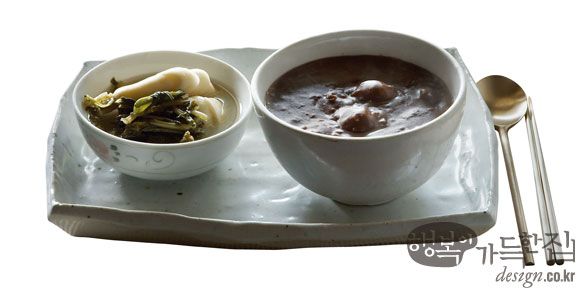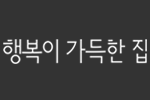
Dongji is one of the 24 solar terms and has the longest day and shortest night of the year where the sun is tilted to the south. It is believed from this day on, the daylight increases one minute each day. In the past, our ancestors believed that the sun would resurrect on Dongji to extend its vital rays until the next Dongji. Therefore, Dongji was considered to be the “little New Year’s Day”. In China, during the Zhou Dynasty, they believed that during Dongji, life force resurrected and thus considered it to be New Year’s Day. Likewise in Korea, during Silla and Goryeo Dynasty, Dongji was considered the New Year’s Day. Old proverbs such as You must pass Dongji to grow one year older or You must eat red bean porridge to grow one year older are derived from this custom.
On Dongji people liquidated all debts and considered the day as a new beginning. The weather on Dongji day was used to predict the fortunes of the following year. When the weather was mild, ancestors believed that epidemic would come about and when the weather was cold and snowing it was a sign of abundance.
One of the common customs on Dongji is cooking and eating red bean porridge, called patjuk. Ancestors enjoyed bird egg shaped balls made from glutinous rice, called saeahlshim along with their patjuk. The reason behind this custom is that Korean people believed that red beans had a mysterious power that drove evil spirits away. In the old days people thought evil spirits hated red beans or the color red. Patjuk was eaten on days of celebration or disaster. When neighbors encountered death, ancestors made patjuk to express condolence. Red bean, pat, is said to have many health benefits; it is good for pain relieving in cases of diarrhea and fever. Our ancestor’s insights can be appreciated to see that they enjoyed pat during the winter.
동지는 24절기 중 하나로 태양이 제일 남쪽에 기울어져 있어 일 년 중 밤이 가장 긴 날이다. 이날을 기점으로 하루에 낮의 길이가 1분씩 길어진다고 해서 옛날 사람들은 동지 때부터 태양이 다시 기운을 회복하는 것이라 여겼다. 따라서 태양신을 숭배하던 때에는 동지를 설 다음가는 작은설로 삼기도 했다. 중국 주나라에서는 생명력과 광명이 부활한다고 해서 동지를 설로 삼았고, 우리나라도 신라에 이어 고려시대 충선왕 이전까지 동지를 설로 지낸 것으로 알려져 있다. 이 때문에 “동지를 지나야 한 살 더 먹는다” 또는 “동지팥죽을 먹어야 진짜 나이를 한 살 더 먹는다”는 말이 전해지며, 날씨가 춥고 밤이 길어 호랑이가 교미한다고 해서 동지를 ‘호랑이 장가가는 날’이라고도 했다.
예로부터 동짓날이 다가오면 사람들은 지난해의 모든 빚을 청산하고 새로운 기분으로 동지를 맞아 하루를 즐겼다. 동짓날의 날씨로 이듬해의 연운을 점치기도 했는데, 날씨가 포근하면 이듬해 질병이 유행하고 눈이 오고 추우면 풍년이 들 징조라고 여겼다.
동짓날에 팥죽을 쑤어 먹는 것은 대표적 민간 풍습 중 하나다. 팥을 삶아 죽을 쑤고 여기에 찹쌀로 단자를 빚어 넣고 끓이는데 단자는 새알만 한 크기로 빚기 때문에 새알심이라 부른다. 팥죽만 먹으면 자칫 신물이 올라올 수 있는데, 이때 동치미를 곁들이면 소화를 돕는다. 팥죽을 쑤면 먼저 사당에 올려 동지 고사를 지내고 각 방과 장독, 헛간 같은 집 안 곳곳에 놓아두었다가 식으면 가족이 한데 모여 먹었다. 팥의 붉은색이 양을 상징하므로 집 안에 있는 귀신을 모조리 쫓아낸다고 믿었다. 팥은 설사, 발열, 종기, 각종 진통에 효과적인 건강식품으로 몸의 기운이 떨어진 겨울의 정점에 팥죽을 쑤어 먹은 것은 우리 조상들의 과학적 처세를 엿볼 수 있는 부분이기도 하다.
*행복 글로벌은 외국인을 위해 우리의 전통문화를 설명해주고 함께 즐기는 안내서입니다.
- 우리 문화 들여다보기 동짓날은 새해맞이 원조
-
12월 22일은 일 년 중 밤이 가장 길고 낮이 가장 짧은 동지입니다. 동지의 기나긴 밤이 지나면 낮 시간이 점점 길어져 양의 기운이 늘어납니다. 예로부터 설 다음가는 중요한 의미를 지녀 ‘작은설’로 불린 동지에 대해 알아봅니다.임희수 객원 기자
디자인하우스 (행복이가득한집 2009년 12월호) ⓒdesign.co.kr, ⓒdesignhouse.co.kr 무단 전재 및 재배포 금지







